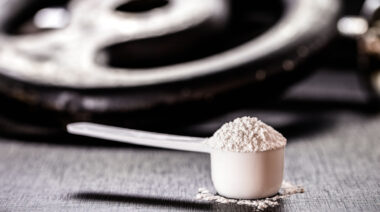Creatine is one of my favorite supplements to recommend to athletes. If your diet is dialed in, you don’t really need protein supplements or vitamins. In fact, outside of convenience, most supplements could be forgone even by athletes. But creatine is one of those rare supplements that is helpful even if you have a healthy diet. It also boosts performance for just about anyone. Not only that, but the basic creatine monohydrate is usually cheap. It’s a home run.
However, there are other forms of creatine besides creatine monohydrate. A recent study in the Journal of Strength and Conditioning looked at a different form of creatine called polyethylene glycosylated creatine, or PEG creatine. PEG is a polymer (a large molecule with repeating parts, like cellulose) that is often bonded to various ingested items like drugs and supplements to increase their absorption rates. When PEG creatine is used instead of creatine monohydrate, smaller than normal doses are needed to achieve significant effects.
In the study, researchers wanted to see if PEG creatine would be effective at these smaller doses for improving a variety of athletic tasks. They compared a placebo to 1.25g and 2.5g of daily PEG creatine supplementation after two weeks and then again after four weeks.
There are a lot of twists and turns ahead, so prepare for a bumpy ride. The PEG creatine did indeed improve several performance markers and indicators. Lower body power, upper body muscular endurance, agility, and body mass were all improved. And that was after just a few weeks.
So despite the small doses – half or less of what is normally taken for creatine monohydrate – results were significant. But an important aspect of this study is that the participants didn’t even exercise. In most studies of a similar design, the participants generally compare a workout program with creatine to one without, but here the participants improved strength, power, and endurance just from taking PEG creatine.
On the flip side of the coin, the study was funded by General Nutrition Corporation, better known as GNC. The authors were grant-funded in a university setting, and the study was double blind, which means that not even the researchers knew who had which dose until the end. Thus, despite the GNC grant, the study seems pretty legit.
According to the researchers of this study, the existing data indicates PEG creatine has similar effects to creatine monohydrate but with smaller doses. Nevertheless, I’d be interested to see more future comparisons between the two, perhaps dose for dose, and with exercise or without.
One final thought: we all know that good old creatine monohydrate is safe and effective, and has been proven so in countless studies. Despite some promising research, PEG creatine doesn’t have the track record that the monohydrate form does. It will be interesting to see what the future holds for this stuff.
References:
1. Clayton L. Camic, et. al., “The Effects of Polyethylene Glycosylated Creatine Supplementation on Anaerobic Performance Measures and Body Composition,” Journal of Strength and Conditioning Research, DOI: 10.1519/JSC.0b013e3182a361a5.
Photo courtesy of Shutterstock.






